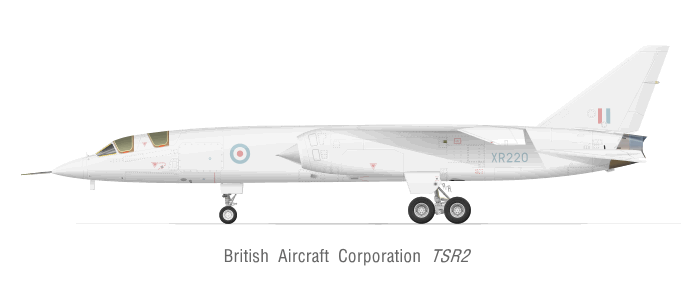TSR-2
Though a fantastic aircraft, TSR-2, had it been built (but forget 150, how many F-111's were ordered in it's place, then after that went, new build Buccaneers?), it would, once production ended, at best, by 1973, left a large hole in the workload for UK aerospace.
Because with TSR-2, no Tornado, quite likely others gone too, like Jaguar, (which means whatever is built as an advanced trainer, lacks the Adour engine for Jaguar, likely a lesser trainer then with the old Viper engine, so a lot of Hawk exports over the long term do not happen).
It was also not very exportable, Mountbatten, (not the government), had as early as 1962/3 put off the Australians, 'it's bound to be cancelled, don't bother'.
The management of the whole programme was appalling, as the really hard stuff began, like getting the very advanced avionics to work as TSR-2 neared service, this would have reared it's head again.
Forget TSR-2, at least to the original specs, in service before 1970/1.
TSR-2, by resulting in other programmes we are familar with today, never happening, would have meant advanced military combat aircraft in the UK, would purely be a licence build effort, from the mid 70's, no large design/flight test effort for Tornado, then Typhoon (Typhoon is essentially a BAe design). No Fly By Wire programmes by modifying that Jaguar, then no EAP advanced demonstrator, the precursor to Eurofighter.
In this light, it's hard to see the level of UK involvement in F-35 to the level we see now, it would have been on a par with the Netherlands on this project.
What killed TSR-2 really, the botched way it was mangaged, opposition not just from politicians, but from other service chiefs-the Navy in particular, the Chief Scientific Advisor to the MoD and others, who politicans relied on for advice.
The whole array of programmes and their cancellations, in the mid 60's, was the fall out still from the 1957 review, which deprived the UK industry of making exportable products, like developed Lightnings and/or P.1121.
What survived, the spec for TSR-2, was 'gold plated' by the RAF since no other type was then in the running.
In all this, the UK was making an type that could do most of what TSR-2 promised, at the much lower price, the Buccaneer.
Hawkers even proposed versions with avionics suited more for overland attack, they had already found that lack of RAF interest, had stymied ecport efforts for this fine aircraft, 'if it's so good, why doesn't the RAF buy it?'
Even so, the TSR-2 would have looked great in RAF colours, it would once developed, have been a formidable machine.
It's a shame, but really, the future was in multi national projects, this was the best way to preserve UK design/production skills, not yet another short production run, or more likely cancellation.
The RAF should have adopted Buccaneer S.2 much sooner, then developing it's systems further.
Sure the Wilson government axed projects, but it was not all about buying from the US, witness the Harrier, Jaguar, Nimrod, what became the Tornado and the Hawk were launched.



